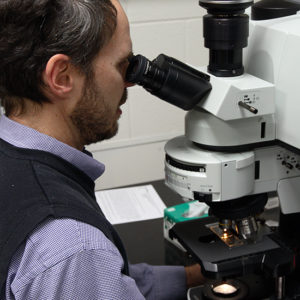 A pistol found in the bottom of a well in James Fort is being conserved collaboratively by the Colonial Williamsburg Foundation (CWF) and Jamestown Rediscovery teams. In 2006, the pistol was pulled out of its watery grave in a well thought to date to 1611. It was immediately re-submerged in water in the Jamestown Rediscovery lab to prevent deterioration—which would manifest as oxidation on the metal and shrinking and cracking of the wooden handle. Because the pistol has multiple material types, i.e. wood and metals, conservation methods performed on one must not affect the others.
A pistol found in the bottom of a well in James Fort is being conserved collaboratively by the Colonial Williamsburg Foundation (CWF) and Jamestown Rediscovery teams. In 2006, the pistol was pulled out of its watery grave in a well thought to date to 1611. It was immediately re-submerged in water in the Jamestown Rediscovery lab to prevent deterioration—which would manifest as oxidation on the metal and shrinking and cracking of the wooden handle. Because the pistol has multiple material types, i.e. wood and metals, conservation methods performed on one must not affect the others.
The conservation team first tackled the iron lock mechanism. Metal conservation is a slow process, in this case made even more so by the fact that portions of the lock mechanism were totally corroded away. Because of this, the corrosion could not fully be removed lest parts of the lock disappear completely. During the metal conservation process, the conservators were ever-mindful of the wooden handle and would re-submerge the pistol after only a few seconds of metal conservation. For more information on the conservation of the metal portions of the pistol, see March 2010’s update.
Before starting the conservation of the wooden stock, Colonial Williamsburg’s conservators examined loose fragments from it in order to identify the species. Because the conservation process for waterlogged wood differs between species, determining the type of wood in the stock is an integral preliminary step. Christopher Swan, furniture conservator for CWF, generously agreed to examine a few of the fragments from our pistol. Transverse, radial and tangential thin sections examined under high magnification allowed Chris to study the cell structure and identify their arrangement. Though the analysis of multiple unique cell identification markers, he was able to determine the stock was a fruitwood, most likely cherry.
related images
- Colonial Williamsburg Foundation’s Chris Swan examines a fragment of the pistol handle using a Fourier transform infrared spectroscopy (FTIR) microscope
- Colonial Williamsburg Foundation’s Chris Swan discusses the pistol handle at the conservation lab of the Colonial Williamsburg Foundation







